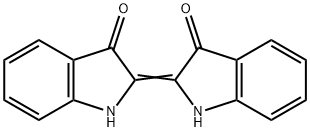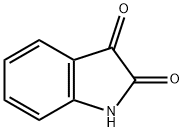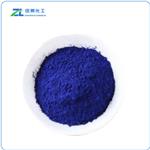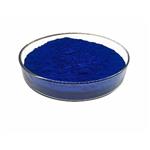Chemical properties
It appears as blue powder, being odorless and slightly soluble in water, ethanol, glycerol and propylene glycol, insoluble in oil. At 25 ℃, the solubility is 1.6% (water), 0.5% (25% ethanol), 0.6% (25% propylene glycol). The 0.05% aqueous solution exhibits dark blue. It has poor performance on all the following aspects: light resistance, heat resistance, acid resistance, alkali resistance, salt tolerance, oxidation resistance and resistance to bacteria. Upon reduction, the color will fade, but the dye is good. The maximum absorption wavelength (610 ± 2) nm. Rat oral LD50: 2g/kg, mice oral LD50 2.5g/kg, ADI 0-5mg/kg (FAO/WHO, 1994).
Indigo Aluminum precipitate is a fine powder with violet blue color, being odorless. It can’t dissolve in water and organic solvents with better light resistance and heat resistance than indigo.
Uses
1. It can be used as food coloring agent with the provisions of China being able to be used in red and green silk and the maximum usage amount of 0.02g/kg; it can be used in the juice (flavor) beverages, carbonated beverages, wine, candy, pastry coloring, dyeing cherry can decorative) and green plum with the maximum usage amount of 0.10g/kg; the maximal usage amount in the dipping pickles of 0.01g/kg.
2. It is mainly used for the dyeing of cotton yarn, cotton, wool or silk.
3. Reduced indigo is mainly used for dyeing cotton yarn and cotton cloth, being the major dye for blue dye denim. It is also used for wool, silk dyeing and as food coloring and organic pigments.
4. Edible blue pigment;
5. It is mainly used for dyeing cotton yarn, cotton cloth, wool or silk. Pure product can be used for the manufacturing of food dyes, or processed into organic pigments.
Production method
It is a kind of edible natural blue pigment made from the leaves of Polygonum tinctorium. The indigo leaves are piled up and frequently subject to watering, to ferment 2 to 3 months to become a black clod like. After ramming using mortar, it is known as the ball indigo with the indigo pigment being 2% to 10%. The wood ash, lime and bran are incorporated into ball indigo and further subject to water mixing, heated to 30~40 ℃, exposed to the air to become insoluble blue indigo.
Phenylglycine is taken as raw material and form indole phenol after subjecting to alkali melting, followed by air oxidation to derive the products. There are many ways to synthesize phenylglycine. In our country, the condensation method of aniline and chloroacetic acid is adopted. For the convenience of the refining of phenylglycine, we can first make its insoluble iron salt to remove the impurities before converting into soluble sodium salt and entering into alkali melting process. .
(1) indigo preparation. Edible indigo is actually indigo disulfonic acid disodium. Indigo is subject to sulfonation with concentrated sulfuric acid, followed by dilution with and then soda ash neutralization. Finally add sodium chloride for salting out, filter, wash and dry to get the finished product.
(2) Preparation of indigo aluminum precipitate. First have aluminum chloride and aluminum sulfate have reaction with alkali such as sodium carbonate for preparation of aluminum hydroxide. Then add it to the indigo water solution for precipitation to derive the products.
Hazards & Safety Information
Category : Toxic substances
Toxic classification : poisoning
Acute toxicity : Oral-mouse LD50> 32000 mg/kg; celiac-mouse LD50: 2200 mg/kg
Flammability and Hazardous properties : being Combustible with combustion producing toxic nitrogen oxide fumes
Storage and transportation characteristics: Ventilated, low temperature and drying
Fire extinguishing agent : dry powder, foam, sand, carbon dioxide, mist water
Description
Indigo, known chemically as indigotin, is a common blue dye that has been highly valued
throughout history and has played a major role in trade and commerce since ancient times.
The term indigo is often used to describe many blue dyes produced from a number of plants.
For example, woad, a blue dye obtained from the plant Isatis tinctoria, was used throughout
the Mediterannean and Europe and is often identified as indigo. True indigo comes from
the leguminous plant of the genus Indigofera.
The Indigofera genus includes several hundred
species, and indigo has been obtained from a number of these, but the dominant species for
the dye are Indigofera tinctoria grown mainly in India and tropical Asia and Indigofera suff ructiosa
from the tropical Americas. The name indigo comes from the Greek indikon and Latin
indicum meaning “dye from India.” There is evidence that indigo was used several thou sand
years b.c.e. Persian rugs containing indigo color exist from several thousand years b.c.e. Textile
artifacts from Egyptian tombs provide evidence of indigo’s use by royalty from as far back as
2500 b.c.e. The writings of Herodotus from approximately 450 b.c.e. mention indigo’s use in
the Mediterranean area.
Chemical Properties
dark violet powder
Occurrence
Indigo is a perennial shrub found in several regions of the world.
History
Indigotin. The blue dye of the ancient world was derived from indigo and woad. Which plant is the oldest is a matter of conjecture. That indigo was known at least four thousand years ago is evident from ancient Sanskrit writings. Cloth dyed with indigotin (CI Natural Blue; CI 75780) has been found in Egyptian tombs and in the graves of the Incas in South America. Indigo belongs to the legume family. The two most important species are Indigo tinctoria and I. suffruticosa, found in India and the Americas, respectively. The leaves of the indigo plant do not contain the dye as such, but in the form of its precursor, a glycoside known as indican.
Uses
Indigo is a chemical compound used as a dye in industrial clothing and textile processes. Also used in the synthesis of organic semiconductors. Dyes and metabolites.
Uses
In recent years researchers have used genetic engineering using Escherichia coli to convert tryptophan into indigo. The desire for natural organic products has also revived traditional production methods of indigo on a small scale. Indigo's dominant use is as a textile dye, but indigo-related compounds have limited use as indicators and in food coloring.the Food and Drug Administration's FD&C Blue #2 contains indigotine (also known as indigo carmine), which is a sulfonated sodium salt of indigo.
Uses
As textile dye. In sutures.
Production Methods
K. Heumann treated N-phenylglycine with alkali and obtained indoxyl (keto form), which on aerial oxidation converted to indigotin. Later, a variation of the original Heumann process was made: aniline, formaldehyde, and hydrogen cyanide react to form phenylglycinonitrile, which is hydrolyzed to phenylglycine. This is the most widely used process for manufacturing indigotin. The greatest improvement in the manufacture of indigotin came when sodamide was used with alkali in the conversion of phenylglycine to indoxyl. Although there is still demand for indigotin for dyeing blue jeans, it has lost a good part of the market to other blue dyes with better dyeing properties.
Definition
indigo: A blue vat dye, C
16H
10N
2O
2.It occurs as the glucoside indican inthe leaves of plants of the genus Indigofera,from which it was formerlyextracted. It is now made synthetically.
Production Methods
The first synthesis of indigo is attributed to Adolf von Baeyer (1835–1917), who began hisquest to synthesize indigo in 1865 but was not able to produce indigo until 1878. The syntheticproduction of indigo was first described by Baeyer and Viggo Drewson in 1882; Baeyeralso identified the structure of indigo in 1882.the Baeyer-Drewson synthesis of indigo startedwith 2-nitrobenzaldehyde and acetone proceeding through a series of steps in alkali solution.Baeyer’s work was not commercially viable, and it was not until 1897 that BASF (BadischeAnalin und Soda Fabrik) started to produce indigo commercially using a process developedby Karl von Heumann (1851–1894) that started with naphthalene. The synthetic productionof indigo spelled the end of traditional methods of indigo production. By the second decadeof the 20th century, nearly all indigo was produced synthetically.
Definition
A double indole derivative.
Biological Functions
Indigo naturalis has a variety of pharmacological activities, such as anti-inflammatory, antioxidant, antibacterial, antiviral, immunomodulatory and so on. It has very good clinical effect on psoriasis, leukemia and ulcerative colitis.
General Description
Dark blue powder with coppery luster. Occurs in isomeric forms (cis and trans). In solid state Indigo is in the trans form.
Air & Water Reactions
Insoluble in water.
Health Hazard
ACUTE/CHRONIC HAZARDS: Indigo may cause irritation of the skin and mucous membranes.
Fire Hazard
Flash point data for Indigo are not available but Indigo is probably combustible.
Flammability and Explosibility
Non flammable
Safety Profile
Mutation data reported. Whenheated to decomposition it emits toxic vapors of NOx.
Purification Methods
First reduce indigo in alkaline solution with sodium hydrosulfite, and filter. The filtrate is then oxidised by air, and the resulting precipitate is filtered off, dried at 65-70o, ground to a fine powder, and extracted with CHCl3 in a Soxhlet extractor. Evaporation of the CHCl3 extract gives the purified dye. [Brode et al. J Am Chem Soc 76 1034 1954; spectral characteristics are listed, Beilstein 24 II 233, 24 III/IV 1791.]
Properties and Applications
|
TEST ITEMS
|
SPECIFICATION
|
|
APPEARANCE
|
BLUE POWDER
|
|
SHADE
|
GREENISH
|
|
HEAT RESISTANCE
|
180 °C min
|
|
LIGHT FASTNESS
|
7
|
|
ACID RESISTANCE
|
3
|
|
ALKALI RESISTANCE
|
4
|
|
FASTNESS TO BLEEDING
|
4
|
|
OIL ABSORPTION
|
40-50%
|
|
SPECIFIC SURFACE
|
27 m
2
/g
|
|
DENSITY
|
1.60 g/cm
3
|
|
RESIDUE ON 80 MESH
|
5.0% max
|
|
WATER SOLUBLE
|
1.0% max
|
|
VOLATITE 105 °C
|
1.0% max
|
|
TINTING STRENGTH
|
100-105 %
|





